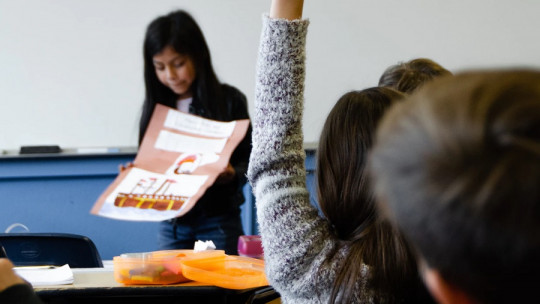The field of education has more and more research that allows us to develop the best models to use.
Within them, that of formative evaluation includes the methodologies with which it is verified how effective the teaching has been We are going to discover in detail how these techniques work and what their importance is to guarantee good training for students.
What is formative evaluation?
Formative evaluation would refer to all the methods that teachers have to continuously verify, throughout the educational process, that students are effectively assimilating the concepts that are being taught to them. These tools are also known as assessment for learning. The process can also be self-assessment by the student, through the practices they carry out in the classroom
Another use of formative evaluation is that it provides an action guide for the teacher so that he knows how he should adapt his teaching in the future, changing some guidelines if the students’ evaluation has not been as expected, or maintaining those aspects that have favored a correct reception of the contents by the students.
The concept of formative assessment emerged through the American academic Michael Scriven, in the 60s, as the idea of a method to check the effectiveness of a study plan and to be able to modify it if it is observed that there are aspects to improve. Scriven was followed by Benjamin Bloom, an American psychologist who continued to define the concept, stating that formative assessment was the mechanism that allowed improving the cycle of teaching and learning that students receive.
The key to the definition given by these two authors lies in the importance they place on the possible changes that the teacher can make based on the results obtained. That is, the key to formative evaluation would be its potential to modify the teaching program in an organic way according to the effectiveness that is being detected It is not a simple indicator of student performance, but has a function much further.
Differences with summative evaluation
Compared to formative evaluation, there is the concept of summative evaluation, which is much more common. In fact, Michael Scriven said that all evaluations can be summative, but only a few of them can be considered formative. Let’s review what are the criteria that make them different.
1. When it takes place
The first differentiation that we find has to do with the moment in which said evaluation is carried out. In the case of summative evaluation, it will be done once the teaching activity has finished. On the contrary, formative evaluation requires that it occur throughout said activity, before it reaches its end
2. What is the objective
The goal of summative evaluation is to be able to make a decision regarding the learning that we estimate that the students have had, that is, how much they have learned about the proposed lesson. However, formative evaluation aims to find points to improve in the teaching methodology used and therefore be more efficient every time.
3. What feedback is there?
In line with the previous point, feedback would play different roles in both types of evaluation. For the summative, it would simply consist of the judgment that determines the student’s grade. On the other hand, in training, The purpose of feedback is to go back to the material and methods used to see how they can be rethought to achieve better results hereafter.
4. What is the frame of reference
The reference framework used in summative evaluation can be of two types. Firstly, the normative type can be used, in which a comparison of each evaluated student is established with respect to all the others. On the other hand, you can choose to use a standardized criterion that will be used for everyone. In the case of formative evaluation This criterion reference framework is always used, so that the group of students is evaluated on said parameters
The usefulness of formative evaluation
Since the term was coined, countless studies have been carried out on formative evaluation, reaching several conclusions about the potential of using this methodology. It has been shown, first of all, that student performance is higher when we use this system. Students are more motivated, since they perceive that they are an active part of the educational system and they are much more than a simple qualification.
To achieve these benefits there are some principles that must be met when applying formative evaluation. Firstly, the learning objectives and the criteria by which it will be considered successful must be stated from the beginning. In addition, debates must be generated in the classroom to verify that the students have effectively understood the concepts. Students should be guided with instructions and comments.
Another point that must be met is that of facilitate the students themselves to collaborate in the task of instructing others, so that those who have assimilated the knowledge more quickly help those who have had more problems understanding it, as part of a team. Finally, it will be necessary to encourage each student to be empowered to take charge of their own learning process and not be mere passive subjects in the classroom.
Different strategies to follow
Within the methods of formative evaluation there is a range of strategies that teachers can choose to achieve their goals. We will see some of them to familiarize ourselves with the most common ones.
1. Understanding goals
We already saw that one of the main rules of formative evaluation is that students understand the objectives of the teaching that is taking place, therefore it is not surprising that the first strategy we found is along the lines of verifying said criterion. The objectives to be achieved must be presented before starting each lesson, but teachers must also explain to the students what path they will follow to achieve these goals.
There are studies that show that When students have prior explanations of the objectives being pursued and the steps they will take to reach them are also explained, they obtain better results than those students who do not receive any information like this and are simply exposed to the contents of the lesson directly.
2. Comments
Other research shows that making comments to students, that is, Give them feedback on how they are performing the task and how to improve their methods, beyond a simple numerical grade, helps and motivates them to improve, facilitating better results than those who are simply graded. That is why comments are the second strategy to follow in formative evaluation.
These comments must be independent of the ratings, that is, they must be carried out as independent processes. The explanation is that in cases in which a comment is attached next to the grade obtained in a test, students show a tendency to pay attention only to the grade, completely ignoring the content of the comment that is next to it.
In these cases, students will be more busy comparing their notes with other classmates instead of stopping to read the words and advice that the teacher has written to try to guide them in the learning process and make them improve.
3. Questions
Asking is the simplest way to obtain information, so it is an essential strategy in formative evaluation to find out how effective we are being in our teaching task. But The simple act of asking does not guarantee that we will obtain the answers we are looking for, so the key will be to ask the right questions. These questions should encourage the student’s thinking process.
We must guide the questions so that a debate is generated among the students so that everyone can reflect using the concepts learned. A good method would be to ask one of the students for their opinion on the explanations of another of them, or to find out the common points or divergences between the points of view of two of their classmates. This way we can obtain good indications about the extent to which this knowledge has penetrated.
Another key is give students long waiting times to reflect, without feeling that there is a rush to immediately obtain the answer. Studies show that this methodology facilitates safer, longer responses, a greater range of response alternatives, more complete reports and a lower non-response rate.









